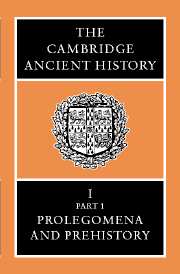Book contents
- Frontmatter
- Contents
- List of Maps
- List of Tables
- List of Text-figures
- Preface
- Chapter I The Geological Ages
- Chapter II Physical Conditions in Eastern Europe, Western Asia and Egypt Before the Period of Agricultural and Urban Settlement
- Chapter III Primitive Man in Egypt, Western Asia and Europe in Palaeolithic Times
- Chapter IV The Evidence of Language
- Chapter V The Earliest Populations of Man in Europe, Western Asia and Northern Africa
- Chapter VI Chronology
- Chapter VII (a) The Earliest Settlements in Western Asia from the Ninth to the End of the Fifth Millennium B.C.
- Chapter VII (b) Anatolia Before 4000 B.C.
- Chapter VIII The Development of Cities From Al-‘Ubaid to the End of Uruk 5
- Chapter IX (a) Predynastic Egypt
- Chapter IX (b) Palestine During the Neolithic and Chalcolithic Periods
- Chapter IX (c) Cyprus in the Neolithic and Chalcolithic Periods
- Chapter X The Stone Age in the Aegean
- Bibliographies
- Index to Maps
- General Index
- Maps
Chapter I - The Geological Ages
Published online by Cambridge University Press: 28 March 2008
- Frontmatter
- Contents
- List of Maps
- List of Tables
- List of Text-figures
- Preface
- Chapter I The Geological Ages
- Chapter II Physical Conditions in Eastern Europe, Western Asia and Egypt Before the Period of Agricultural and Urban Settlement
- Chapter III Primitive Man in Egypt, Western Asia and Europe in Palaeolithic Times
- Chapter IV The Evidence of Language
- Chapter V The Earliest Populations of Man in Europe, Western Asia and Northern Africa
- Chapter VI Chronology
- Chapter VII (a) The Earliest Settlements in Western Asia from the Ninth to the End of the Fifth Millennium B.C.
- Chapter VII (b) Anatolia Before 4000 B.C.
- Chapter VIII The Development of Cities From Al-‘Ubaid to the End of Uruk 5
- Chapter IX (a) Predynastic Egypt
- Chapter IX (b) Palestine During the Neolithic and Chalcolithic Periods
- Chapter IX (c) Cyprus in the Neolithic and Chalcolithic Periods
- Chapter X The Stone Age in the Aegean
- Bibliographies
- Index to Maps
- General Index
- Maps
Summary
I. INTRODUCTION
The perspective of history begins with the origin of the earth, and develops through geological time until the stage is ultimately set for human evolution. The age of the earth, so long a matter of grave controversy, is now fairly reliably known as the result of the development of delicate methods of measurement that make use of the radioactive properties of certain naturally occurring elements, and is of the order of 4,500 million years. For much of this period there was apparently no life upon the earth, and certainly any life that existed left no traces that have yet been recognized as such. Yet year by year records of primitive life are announced from older and older rocks, until now there are claims going back more than 2,000 million years. Nevertheless, complex life forms that have lef£ abundant traces as fossils are not found in rocks older than those of the Cambrian system, which may be accepted as having been laid down about 600 million years ago. This dividing line between Cambrian and Pre-Cambrian rocks, between those with abundant fossil remains and those to all intents and purposes without any is clearly of paramount importance to the palaeontologist studying the forms of organic evolution, and to the stratigraphical geologist who depends so importantly upon his labours. The greater part of all geological writing is thus concerned with Cambrian and Post-Cambrian time, but the nongeologist must be careful to avoid the inference from this that little of importance occurred before the Cambrian. More than four-fifths of the history of our earth was over before the fossil record opens.
From that moment, however, it is clear that the evolution of life was both multifarious and rapid. The remains preserved in the Lower Palaeozoic systems (Cambrian, Ordovician and Silurian) are all of marine organisms; land plants and land animals did not appear until the Upper Palaeozoic, in the Devonian and Carboniferous, respectively. The giant reptiles flourished in the era represented by the Mesozoic systems (Triassic, Jurassic and Cretaceous). Mammals made a slow start with Triassic or even Permian origins, and did not rise to dominance until Tertiary ( = Cainozoic) times. The genus Homo, one of the latest additions to the mammalian fauna, appeared less than two million years ago, and Homo sapiens, our own species, has been present on earth in only the last fiftieth of that period.
- Type
- Chapter
- Information
- The Cambridge Ancient History , pp. 1 - 34Publisher: Cambridge University PressPrint publication year: 1970



